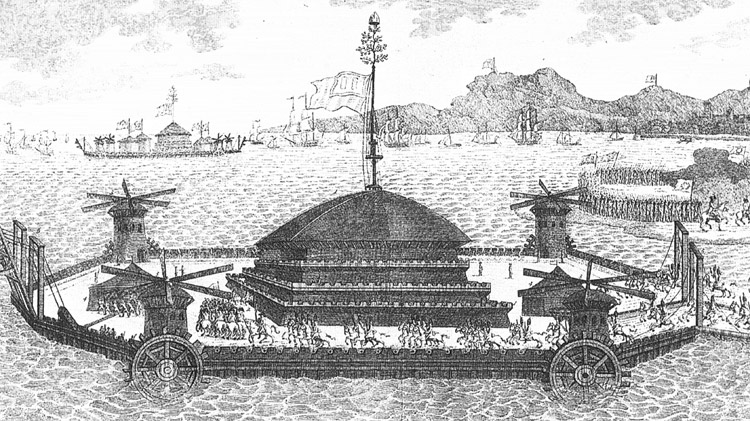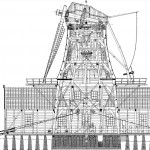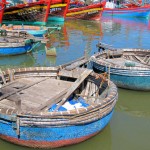This engraving, published in 1798, shows the gigantic St. Malo raft, designed in 1791 during the French Revolution. The engraving informs us that this extraordinary structure was 600 feet long by 300 broad, mounts 500 pieces of cannon, 36 and 48-pounders, and is to convey 15,000 troops for the invasion of England. In the midst is a bomb-proof, metal-sheathed citadel.
The St. Malo raft was supposed to be propelled by means of 4 large paddle wheels powered by 4 windmills. Whenever the wind apparatus should be unavailable, the paddle-wheels could be worked by horsepower. Squadrons of cavalry are seen proceeding at full gallop, passing across the surface, having entered the great floating affair by a set of draw-bridges at one end, which can evidently be lifted up when the process of embarkation is completed. They are deploying round and passing into an arched entrance to quarters provided for them in the basement of the central fortress or citadel. Note the second raft in the distance.
These formidable appliances for the invasion of England were never constructed, of course. The idea originated as propaganda to convince the more gullible section of the French public that the notion of the invasion was to be taken seriously. The English, on the other hand, used these posters to arouse British patriotism and to raise awareness against possible French invasion.
Napoleon Bonaparte wrote to Tayllerand, his Minister for Foreign Affairs, in 1797:
“The government must destroy the English monarchy, or expect itself to be destroyed by these intriguing and enterprising islanders. The present moment offers a capital opportunity. Let us concentrate all efforts on the Navy, and annihilate England. That done, Europe is at our feet.”
A contemporary publication, entitled “Recherche sur l’Usage des Radeaux pour une Descente”, deals fully with this chimerical means of transport, and gives elaborate statistics to prove the absurdity of the plan, which was not, of course, ever seriously intended by those in authority:
“One of them would require thirty fir trees in length, 900 in breadth and eight in height, in all 216,000 trees; each a foot square, each containing sixty cubic feet, each foot weighing from fifty-two to fifty-five pounds, would make 3120 to 3300 feet, or three horse loads; and the whole would require 618,000 horses or 108,000 carriages and as many carters to bring them from the forest to the sea. The total weight of one raft would be 44,500 tons.”
The foreseen invasion never happened. Napoleon abandoned the plan because he realised he could not cross the Channel as long as the powerful Royal Navy was patrolling it. Admiral Jervis of England proved right when he said:
“I do not say that the French cannot come – I only say they cannot come by sea.”
Napoleon also seriously considered using a fleet of troop carrying balloons as part of his proposed invasion force. But, his air service chief said the proposed aerial invasion would fail because of the winds. A tunnel was also considered.
Napoleon kept the idea of the invasion alive, but then planned to hit England indirectly, by conquering Egypt, where English trade interests were high. In May of the same year, Napoleon set sail for Alexandria.
———————————————————————————————————————————————-
- “Two Napoleon Relics“, a booklet published in 1895
- “Napoleon and the invasion of England, Vol.1″, a book from 1908.
- “Napoleon’s planned invasion of the United Kingdom“, Wikipedia.
- “Anti-Napoleon caricature and propaganda in England 1798-1803“, Bogdan Andrei Bernevig.
- Guido Vigevano’s wind car: 14th century war vehicle
- Wind powered factories: history and future of industrial windmills
- A steam powered submarine: the Ictíneo II






